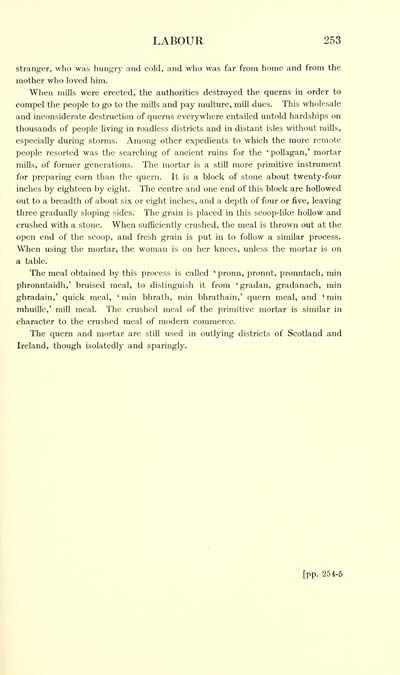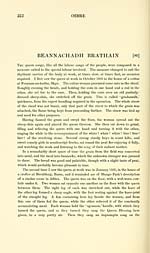Blair Collection > Carmina gadelica > Volume 1
(295)
Download files
Complete book:
Individual page:
Thumbnail gallery: Grid view | List view

LABOUR 253
stranger, who was hungry and cnld, and who was far from home and from the
mother wlio loved him.
When mills were erected, the authorities destroyed the querns in order to
compel the people to go to the mills and pay multure, mill dues. This wholesale
and inconsiderate destruction of querns everywhere enbiiled untold hardships on
thousands of people living in roadless districts and in distant isles without mills,
especially during storms. Among other expedients to which the more remote
people resorted was the searching of ancient ruins for the ' poUagan,' mortar
mills, of former generations. The mortar is a still more primitive instrument
for preparing corn than the quern. It is a block of stone about twenty-four
inches by eighteen by eight. The centre and one end of this block are hollowed
out to a breadth of about six or eight inches, and a depth of four or five, leaving
three gradually sloping sides. The grain is placed in this scoop-like hoUow and
crushed with a stone. When sufficiently crushed, the meal is thrown out at the
open end of the scoop, and fresh grain is put in to follow a similar process.
When using the mortar, the woman is on her knees, unless the mortar is on
a table.
The meal obtained by this process is called 'pronn, pronnt, pronntach, min
phronntaidh,' bruised meal, to distinguish it from 'gradan, gradanach, min
ghradain," quick meal, ' min bhrath, min bhrathain,' quern meal, and ' min
mhuillc,' mill meal. The crushed meal of the primitive mortar is similar in
character to the crushed meal of modern commerce.
The quern and mortar are still used in outlying districts of Scotland and
Ireland, though isolatedly and sparingly.
[pp. 254-5
stranger, who was hungry and cnld, and who was far from home and from the
mother wlio loved him.
When mills were erected, the authorities destroyed the querns in order to
compel the people to go to the mills and pay multure, mill dues. This wholesale
and inconsiderate destruction of querns everywhere enbiiled untold hardships on
thousands of people living in roadless districts and in distant isles without mills,
especially during storms. Among other expedients to which the more remote
people resorted was the searching of ancient ruins for the ' poUagan,' mortar
mills, of former generations. The mortar is a still more primitive instrument
for preparing corn than the quern. It is a block of stone about twenty-four
inches by eighteen by eight. The centre and one end of this block are hollowed
out to a breadth of about six or eight inches, and a depth of four or five, leaving
three gradually sloping sides. The grain is placed in this scoop-like hoUow and
crushed with a stone. When sufficiently crushed, the meal is thrown out at the
open end of the scoop, and fresh grain is put in to follow a similar process.
When using the mortar, the woman is on her knees, unless the mortar is on
a table.
The meal obtained by this process is called 'pronn, pronnt, pronntach, min
phronntaidh,' bruised meal, to distinguish it from 'gradan, gradanach, min
ghradain," quick meal, ' min bhrath, min bhrathain,' quern meal, and ' min
mhuillc,' mill meal. The crushed meal of the primitive mortar is similar in
character to the crushed meal of modern commerce.
The quern and mortar are still used in outlying districts of Scotland and
Ireland, though isolatedly and sparingly.
[pp. 254-5
Set display mode to: Large image | Transcription
Images and transcriptions on this page, including medium image downloads, may be used under the Creative Commons Attribution 4.0 International Licence unless otherwise stated. ![]()
| Early Gaelic Book Collections > Blair Collection > Carmina gadelica > Volume 1 > (295) |
|---|
| Permanent URL | https://digital.nls.uk/75762915 |
|---|
| Attribution and copyright: |
|
|---|---|
| Description | A selection of books from a collection of more than 500 titles, mostly on religious and literary topics. Also includes some material dealing with other Celtic languages and societies. Collection created towards the end of the 19th century by Lady Evelyn Stewart Murray. |
|---|
| Description | Selected items from five 'Special and Named Printed Collections'. Includes books in Gaelic and other Celtic languages, works about the Gaels, their languages, literature, culture and history. |
|---|

